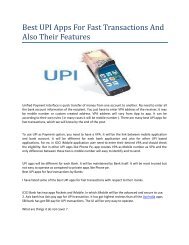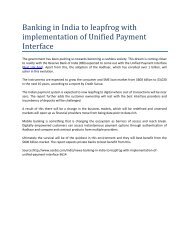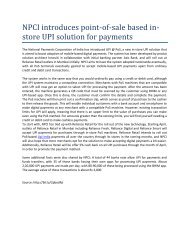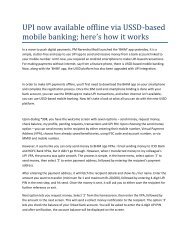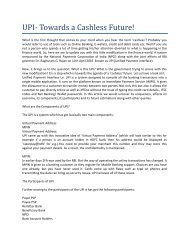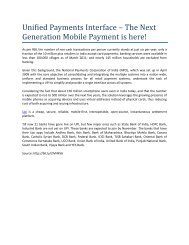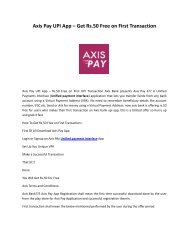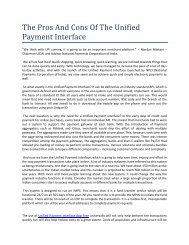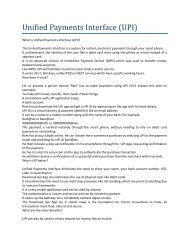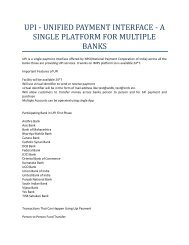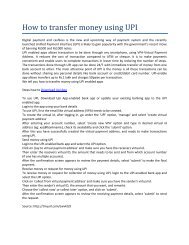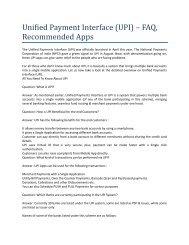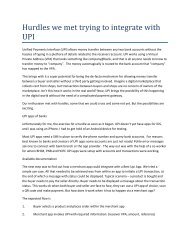Unified Payments Interface (UPI)
You also want an ePaper? Increase the reach of your titles
YUMPU automatically turns print PDFs into web optimized ePapers that Google loves.
<strong>Unified</strong> <strong>Payments</strong> <strong>Interface</strong> (<strong>UPI</strong>)<br />
What is <strong>Unified</strong> <strong>Payments</strong> <strong>Interface</strong> (<strong>UPI</strong>)?<br />
The United <strong>Payments</strong> <strong>Interface</strong> is a system for instant, electronic payments through your smart phone.<br />
It authenticates the identity of the user like a debit card does using the phone as a tool instead of a<br />
separate card.<br />
It is an advanced version of Immediate Payment Service (IMPS) which was used to transfer money<br />
between bank accounts.<br />
Like IMPS, <strong>UPI</strong> will facilitate round-the-clock funds transfer service.<br />
It works 24×7, 365 days, unlike RTGS or NEFT services which have specific working hours.<br />
How does it work?<br />
Let us assume a person named ‘Ram’ has to make payments using <strong>UPI</strong> (let’s explain this with an<br />
example).<br />
To make <strong>UPI</strong> money transfer, Ram needs 2 basic things:<br />
A smartphone with <strong>UPI</strong> application (app),<br />
A bank account.<br />
Ram has to download the <strong>UPI</strong> app and get a <strong>UPI</strong> ID by registering on the app with his bank details.<br />
<strong>UPI</strong> ID is a virtual identity (a payment identifier) like an email address.<br />
It can be a name or a mobile number along with the name of your bank. For example-<br />
Ram@sbi or Ram@icici<br />
9900000099@hdfc or 9900000099@axis<br />
The payment is verified instantly through the smart phone, without needing to rely on debit card<br />
payment or net banking.<br />
Ram has to buy a book online. He can initiate the e-commerce purchase by selecting <strong>UPI</strong> as the payment<br />
mode and providing his <strong>UPI</strong> ID Ram@sbi.<br />
He then receives a pop-up notification on his smartphone through the ‘<strong>UPI</strong> App’ requesting confirmation<br />
of the payment.<br />
He has to enter his secure pin on the app to authenticate the purchase transaction.<br />
He will then receive a confirmation of a successful online purchase from the merchant within seconds.<br />
Why is <strong>UPI</strong> better?<br />
<strong>Unified</strong> <strong>Payments</strong> <strong>Interface</strong> eliminates the need to share your name, your bank account number, IFSC<br />
code, or bank branch.<br />
Download Upi App also eliminates the use of physical tools like debit cards.<br />
It also eliminates the need to use multi-step processes like net-banking, which are prone to phishing due<br />
to insecure frameworks.<br />
It is a very simple application and can be used by anyone.<br />
The authentication is instant and secure and can be initiated anywhere.<br />
It opens up the pathway for a completely cashless digital society.<br />
The Download Upi App (as it stands now) is the foundation for future innovations to make all<br />
transactions more fluid, natural and secure.<br />
What are the other benefits?<br />
<strong>UPI</strong> can also be used to send a request for money, like an invoice.
For example, Ram can become a merchant, and take payment for any goods or services he is providing<br />
from clients account to his account.<br />
All companies like Uber, Ola, Big Basket, Zomato, BookMyShow, can register their virtual identifiers on<br />
the <strong>UPI</strong> system and receive funds from a customer’s bank account through the <strong>UPI</strong>.<br />
Customers can also use the <strong>Unified</strong> <strong>Payments</strong> <strong>Interface</strong> to make online payments of utility bills and<br />
school fees.<br />
Challenges that prompted the need for Download Upi App<br />
The number of non-cash transactions per person per year is only 6. This is bad because cash transactions<br />
are often hard to trace. Cashless transactions can be tracked, eventually eliminating black money from<br />
society.<br />
Only a fraction of retailers (6 lakh) in India have card payment facilities. The biggest sufferers in these<br />
are local and small shops. However, the ubiquity and ever-falling prices of smart phones is making it an<br />
attractive and convenient option to facilitate transactions.<br />
Of the six lakh villages in the country, fewer than one lakh villages have banking services (as of May<br />
2011). Financial inclusion has also been hard to achieve. It is only through recent innovations like Direct<br />
Benefits Transfer (DBT) and Pradhan Mantri Jan Dhan Yojana (PMJDY) that financial inclusion has<br />
become a reality.<br />
There are more than 150 million smartphone users in the country, a number set to more than triple<br />
within 5 years. Here was a readymade solution that wasn’t being addressed.<br />
Future Innovations through <strong>Unified</strong> <strong>Payments</strong> <strong>Interface</strong><br />
The present form of the app, while revolutionary, is not the end product. The document detailing<br />
technical specifications of the app details upcoming features that will merge the <strong>UPI</strong> and identification<br />
tools like Aadhaar for even smoother functioning. Some of these are:<br />
Aadhaar Enabled <strong>Payments</strong> System (AEPS) – This will allow users to authenticate payments using<br />
biometric information like fingerprint that will be verified against the Aadhaar database and your linked<br />
bank account. This could eliminate the need to even use your smartphone for authentication.<br />
Aadhaar <strong>Payments</strong> Bridge (APB) – Remittances can be made to an Aadhaar number without providing<br />
other details. This would help with direct remittances of government subsidies and direct benefits.<br />
Micro-ATMS – Withdrawal of money without the use of a card.<br />
Bill Splitting – Bills can be split between different parties instantly.<br />
Other important points about <strong>UPI</strong><br />
Architecture of <strong>UPI</strong> is based around the IMPS framework.<br />
<strong>UPI</strong> is launched by NPCI with RBI’s vision of migrating Indian economy towards a ‘less-cash’ and more<br />
digital society.<br />
Every consumer with a bank account can avail the benefits of this service.<br />
<strong>UPI</strong> is expected to give now popular mobile wallets like Mobikwik and PayTM as well as instant mobile<br />
payment solutions like Chiller a run for their money.<br />
Around 29 banks have concurred to provide <strong>UPI</strong> service to their customers as payment service providers<br />
(PSPs).<br />
P. Hota is the Managing Director & CEO of NPCI, which also handles the RuPay Card. NCPI was set up in<br />
April 2009.<br />
After the launch of <strong>UPI</strong>, India is said to have one of the most sophisticated public payments<br />
infrastructure in the world.
Source: http://bit.ly/1TiseRs




